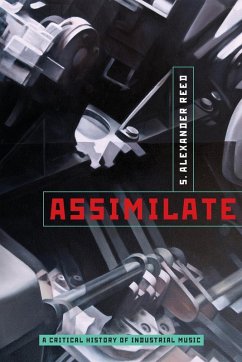- Broschiertes Buch
- Merkliste
- Auf die Merkliste
- Bewerten Bewerten
- Teilen
- Produkt teilen
- Produkterinnerung
- Produkterinnerung
In Assimilate, S. Alexander Reed provides the first ever critical history of industrial music. Through a series of revealing explorations of works spanning the entirety of industrial music's past, and drawing on extensive interviews, Reed paints a thorough historical picture that includes not only the bands, but the structures that supported them, and the scenes they created.
Andere Kunden interessierten sich auch für
![AFRICAN IMAGINATION IN MUSIC P AFRICAN IMAGINATION IN MUSIC P]() V Kofi AgawuAFRICAN IMAGINATION IN MUSIC P37,99 €
V Kofi AgawuAFRICAN IMAGINATION IN MUSIC P37,99 €![Music and the French Enlightenment Music and the French Enlightenment]() Cynthia VerbaMusic and the French Enlightenment75,99 €
Cynthia VerbaMusic and the French Enlightenment75,99 €![Anxiety Muted Anxiety Muted]() Stanley C. II PelkeyAnxiety Muted52,99 €
Stanley C. II PelkeyAnxiety Muted52,99 €![Music and Youth Culture in Latin America Music and Youth Culture in Latin America]() Pablo VilaMusic and Youth Culture in Latin America45,99 €
Pablo VilaMusic and Youth Culture in Latin America45,99 €![The Revolution Will Not Be Televised The Revolution Will Not Be Televised]() Noriko ManabeThe Revolution Will Not Be Televised41,99 €
Noriko ManabeThe Revolution Will Not Be Televised41,99 €![Arranging Gershwin Arranging Gershwin]() Ryan BanagaleArranging Gershwin31,99 €
Ryan BanagaleArranging Gershwin31,99 €![Understanding Sound Tracks Through Film Theory Understanding Sound Tracks Through Film Theory]() Elsie WalkerUnderstanding Sound Tracks Through Film Theory52,99 €
Elsie WalkerUnderstanding Sound Tracks Through Film Theory52,99 €-
-
-
In Assimilate, S. Alexander Reed provides the first ever critical history of industrial music. Through a series of revealing explorations of works spanning the entirety of industrial music's past, and drawing on extensive interviews, Reed paints a thorough historical picture that includes not only the bands, but the structures that supported them, and the scenes they created.
Hinweis: Dieser Artikel kann nur an eine deutsche Lieferadresse ausgeliefert werden.
Hinweis: Dieser Artikel kann nur an eine deutsche Lieferadresse ausgeliefert werden.
Produktdetails
- Produktdetails
- Verlag: OUP US
- Seitenzahl: 376
- Erscheinungstermin: 5. Juni 2013
- Englisch
- Abmessung: 234mm x 156mm x 23mm
- Gewicht: 639g
- ISBN-13: 9780199832606
- ISBN-10: 0199832609
- Artikelnr.: 38078154
- Herstellerkennzeichnung
- Libri GmbH
- Europaallee 1
- 36244 Bad Hersfeld
- gpsr@libri.de
- Verlag: OUP US
- Seitenzahl: 376
- Erscheinungstermin: 5. Juni 2013
- Englisch
- Abmessung: 234mm x 156mm x 23mm
- Gewicht: 639g
- ISBN-13: 9780199832606
- ISBN-10: 0199832609
- Artikelnr.: 38078154
- Herstellerkennzeichnung
- Libri GmbH
- Europaallee 1
- 36244 Bad Hersfeld
- gpsr@libri.de
S. Alexander Reed is Assistant Professor of Music Theory at the University of Florida. He has published and presented research on vocal timbre, embodiment, postpunk music, and the recordings of Nine Inch Nails, Laurie Anderson, Rammstein, and Tori Amos. Reed has released five albums with his own gothic-industrial band, ThouShaltNot.
Introduction
1. A Fading Vision Lost in Time
2. The Pan-Revolutionary
3. The "I"-Word
Part 1: Technology and the Preconditions of Industrial Music
I. Italian Futurism
1. Industry
2. The Aesthetics of the Machine
3. Crash
II. William S. Burroughs
1. Junkie
2. The Control Machines
3. Brainwashing and the Conflation of Authority
4. Mediatic Verses
5. The Cut-Up
6. Process as Composition
7. Media
8. Techno-Ambivalence
III. Industrial Music and the Avant-Garde
1. Noise and Revisionism
2. The Revolutionary Class
Part 2: Industrial Geography
IV. Northern England
1. Progress in Hell
2. The Original Sound of Sheffield
3. Meatwhistle and ClockDVA
4. Throbbing Gristle
5. Manchester in the Shadow of War
V. Berlin
1. An Island Out of This Planet
2. Strategies Against Architecture
3. German-ness
4. Ingenious Dilettantes
5. West Germany Beyond Berlin
VI. San Francisco
1. Madness in Any Direction, at Any Hour
2. Monte Cazazza and Self-Propaganda
3. Z 'ev and Survival Research Laboratories
4. Factrix and Chrome
VII. Mail Art, Tape Technology, and the Network
1. Fluxus and UFOs
2. A History of Tape Trading
3. Taping as a Political Act
4. The Eternal Network
5. A Virtual Scene
Part 3: Industrial Music as Music
VIII. The Tyranny of the Beat: Dance Music and Identity Crisis
1. Those Heady Days of Idealism Are Over
2. Irony
3. Technology and Rhythm
4. Futurist Pop
5. Pleasure
6. Industrial Identity
IX. "After Cease to Exist ": England 1981-1985
1. The Mission is Terminated
2. London
3. Beyond London
X. Body to Body: Belgian EBM 1981-1985
1. A Satellite State
2. Luc Van Acker
3. Front
4. Musical Order
5. Bodily Order
XI. Industrial Music as a Theatre of Cruelty
1. Artaud-Damaged
2. Theatricalities of All Kinds
XII. "She's a Sleeping Beast": Skinny Puppy and the Feminine Gothic
1. From Pop to Puppy
2. Vancouver's Fertile Ground
3. Disrupting Maleness
4. The Feminine Gothic
Part 4: People and Industrial Music
XIII. Wild Planet: WaxTrax! Records and Global Dance Scenes
1. Industrial Music and the Mainstream
2. The Beginnings of WaxTrax!
3. Ministry
4. Mixing and Merging
5. The Business of Chaos
6. Clubbing and Participatory Culture
7. New Beat
8. The WaxTrax! Heyday
XIV. Q: Why Do We Act Like Machines? A: We Do Not.
1. Pretty Hate Machine
2. Industrial Harmony
3. Language, the Self, and Gender
4. Get Me an Industrial Band
5. Resembling the Machine
XV. Death
1. Death as Event
2. Death as Metaphor
3. Death as Fashion
4. New Life
XVI. Wonder
1. Covenant and the Ubiquitous Sublime
2. Apoptygma Berzerk and the Spontaneous Sublime
3. VNV Nation and the Unthinkable Sublime
4. The Futurepop Backlash
5. Clubbed to Death
6. The Longevity of Industrial Bands
7. Industrial Music Is Dead?
Part 5: Meaning and Revolution
XVII. Back and Forth: Industrial Music and Fascism
1. Extremism as the Norm
2. Silent Politics
3. Loud Apolitics
4. The Effects of Fascism's Spectre
5. Fascist Assimilation
6. The Hidden Reverse
XVIII. White Souls in Black Suits: Industrial Music and Race
1. Whiteness
2. The Inheritance of Blues, Jazz, and Dub
3. Exotica, Caricature, and the Techno-Oblivious
4. Technology and Racial Engagement
5. Black and White
6. Repetition and the English Ballad
XIX. Is There Any Escape for Noise?
1. Unpalatable Truths
2. The First Two Options
3. Transgression as Law
4. The Future Happened Already
5. Pleasure, Flag Planting, and Revolution
6. The Third Mind
1. A Fading Vision Lost in Time
2. The Pan-Revolutionary
3. The "I"-Word
Part 1: Technology and the Preconditions of Industrial Music
I. Italian Futurism
1. Industry
2. The Aesthetics of the Machine
3. Crash
II. William S. Burroughs
1. Junkie
2. The Control Machines
3. Brainwashing and the Conflation of Authority
4. Mediatic Verses
5. The Cut-Up
6. Process as Composition
7. Media
8. Techno-Ambivalence
III. Industrial Music and the Avant-Garde
1. Noise and Revisionism
2. The Revolutionary Class
Part 2: Industrial Geography
IV. Northern England
1. Progress in Hell
2. The Original Sound of Sheffield
3. Meatwhistle and ClockDVA
4. Throbbing Gristle
5. Manchester in the Shadow of War
V. Berlin
1. An Island Out of This Planet
2. Strategies Against Architecture
3. German-ness
4. Ingenious Dilettantes
5. West Germany Beyond Berlin
VI. San Francisco
1. Madness in Any Direction, at Any Hour
2. Monte Cazazza and Self-Propaganda
3. Z 'ev and Survival Research Laboratories
4. Factrix and Chrome
VII. Mail Art, Tape Technology, and the Network
1. Fluxus and UFOs
2. A History of Tape Trading
3. Taping as a Political Act
4. The Eternal Network
5. A Virtual Scene
Part 3: Industrial Music as Music
VIII. The Tyranny of the Beat: Dance Music and Identity Crisis
1. Those Heady Days of Idealism Are Over
2. Irony
3. Technology and Rhythm
4. Futurist Pop
5. Pleasure
6. Industrial Identity
IX. "After Cease to Exist ": England 1981-1985
1. The Mission is Terminated
2. London
3. Beyond London
X. Body to Body: Belgian EBM 1981-1985
1. A Satellite State
2. Luc Van Acker
3. Front
4. Musical Order
5. Bodily Order
XI. Industrial Music as a Theatre of Cruelty
1. Artaud-Damaged
2. Theatricalities of All Kinds
XII. "She's a Sleeping Beast": Skinny Puppy and the Feminine Gothic
1. From Pop to Puppy
2. Vancouver's Fertile Ground
3. Disrupting Maleness
4. The Feminine Gothic
Part 4: People and Industrial Music
XIII. Wild Planet: WaxTrax! Records and Global Dance Scenes
1. Industrial Music and the Mainstream
2. The Beginnings of WaxTrax!
3. Ministry
4. Mixing and Merging
5. The Business of Chaos
6. Clubbing and Participatory Culture
7. New Beat
8. The WaxTrax! Heyday
XIV. Q: Why Do We Act Like Machines? A: We Do Not.
1. Pretty Hate Machine
2. Industrial Harmony
3. Language, the Self, and Gender
4. Get Me an Industrial Band
5. Resembling the Machine
XV. Death
1. Death as Event
2. Death as Metaphor
3. Death as Fashion
4. New Life
XVI. Wonder
1. Covenant and the Ubiquitous Sublime
2. Apoptygma Berzerk and the Spontaneous Sublime
3. VNV Nation and the Unthinkable Sublime
4. The Futurepop Backlash
5. Clubbed to Death
6. The Longevity of Industrial Bands
7. Industrial Music Is Dead?
Part 5: Meaning and Revolution
XVII. Back and Forth: Industrial Music and Fascism
1. Extremism as the Norm
2. Silent Politics
3. Loud Apolitics
4. The Effects of Fascism's Spectre
5. Fascist Assimilation
6. The Hidden Reverse
XVIII. White Souls in Black Suits: Industrial Music and Race
1. Whiteness
2. The Inheritance of Blues, Jazz, and Dub
3. Exotica, Caricature, and the Techno-Oblivious
4. Technology and Racial Engagement
5. Black and White
6. Repetition and the English Ballad
XIX. Is There Any Escape for Noise?
1. Unpalatable Truths
2. The First Two Options
3. Transgression as Law
4. The Future Happened Already
5. Pleasure, Flag Planting, and Revolution
6. The Third Mind
Introduction
1. A Fading Vision Lost in Time
2. The Pan-Revolutionary
3. The "I"-Word
Part 1: Technology and the Preconditions of Industrial Music
I. Italian Futurism
1. Industry
2. The Aesthetics of the Machine
3. Crash
II. William S. Burroughs
1. Junkie
2. The Control Machines
3. Brainwashing and the Conflation of Authority
4. Mediatic Verses
5. The Cut-Up
6. Process as Composition
7. Media
8. Techno-Ambivalence
III. Industrial Music and the Avant-Garde
1. Noise and Revisionism
2. The Revolutionary Class
Part 2: Industrial Geography
IV. Northern England
1. Progress in Hell
2. The Original Sound of Sheffield
3. Meatwhistle and ClockDVA
4. Throbbing Gristle
5. Manchester in the Shadow of War
V. Berlin
1. An Island Out of This Planet
2. Strategies Against Architecture
3. German-ness
4. Ingenious Dilettantes
5. West Germany Beyond Berlin
VI. San Francisco
1. Madness in Any Direction, at Any Hour
2. Monte Cazazza and Self-Propaganda
3. Z 'ev and Survival Research Laboratories
4. Factrix and Chrome
VII. Mail Art, Tape Technology, and the Network
1. Fluxus and UFOs
2. A History of Tape Trading
3. Taping as a Political Act
4. The Eternal Network
5. A Virtual Scene
Part 3: Industrial Music as Music
VIII. The Tyranny of the Beat: Dance Music and Identity Crisis
1. Those Heady Days of Idealism Are Over
2. Irony
3. Technology and Rhythm
4. Futurist Pop
5. Pleasure
6. Industrial Identity
IX. "After Cease to Exist ": England 1981-1985
1. The Mission is Terminated
2. London
3. Beyond London
X. Body to Body: Belgian EBM 1981-1985
1. A Satellite State
2. Luc Van Acker
3. Front
4. Musical Order
5. Bodily Order
XI. Industrial Music as a Theatre of Cruelty
1. Artaud-Damaged
2. Theatricalities of All Kinds
XII. "She's a Sleeping Beast": Skinny Puppy and the Feminine Gothic
1. From Pop to Puppy
2. Vancouver's Fertile Ground
3. Disrupting Maleness
4. The Feminine Gothic
Part 4: People and Industrial Music
XIII. Wild Planet: WaxTrax! Records and Global Dance Scenes
1. Industrial Music and the Mainstream
2. The Beginnings of WaxTrax!
3. Ministry
4. Mixing and Merging
5. The Business of Chaos
6. Clubbing and Participatory Culture
7. New Beat
8. The WaxTrax! Heyday
XIV. Q: Why Do We Act Like Machines? A: We Do Not.
1. Pretty Hate Machine
2. Industrial Harmony
3. Language, the Self, and Gender
4. Get Me an Industrial Band
5. Resembling the Machine
XV. Death
1. Death as Event
2. Death as Metaphor
3. Death as Fashion
4. New Life
XVI. Wonder
1. Covenant and the Ubiquitous Sublime
2. Apoptygma Berzerk and the Spontaneous Sublime
3. VNV Nation and the Unthinkable Sublime
4. The Futurepop Backlash
5. Clubbed to Death
6. The Longevity of Industrial Bands
7. Industrial Music Is Dead?
Part 5: Meaning and Revolution
XVII. Back and Forth: Industrial Music and Fascism
1. Extremism as the Norm
2. Silent Politics
3. Loud Apolitics
4. The Effects of Fascism's Spectre
5. Fascist Assimilation
6. The Hidden Reverse
XVIII. White Souls in Black Suits: Industrial Music and Race
1. Whiteness
2. The Inheritance of Blues, Jazz, and Dub
3. Exotica, Caricature, and the Techno-Oblivious
4. Technology and Racial Engagement
5. Black and White
6. Repetition and the English Ballad
XIX. Is There Any Escape for Noise?
1. Unpalatable Truths
2. The First Two Options
3. Transgression as Law
4. The Future Happened Already
5. Pleasure, Flag Planting, and Revolution
6. The Third Mind
1. A Fading Vision Lost in Time
2. The Pan-Revolutionary
3. The "I"-Word
Part 1: Technology and the Preconditions of Industrial Music
I. Italian Futurism
1. Industry
2. The Aesthetics of the Machine
3. Crash
II. William S. Burroughs
1. Junkie
2. The Control Machines
3. Brainwashing and the Conflation of Authority
4. Mediatic Verses
5. The Cut-Up
6. Process as Composition
7. Media
8. Techno-Ambivalence
III. Industrial Music and the Avant-Garde
1. Noise and Revisionism
2. The Revolutionary Class
Part 2: Industrial Geography
IV. Northern England
1. Progress in Hell
2. The Original Sound of Sheffield
3. Meatwhistle and ClockDVA
4. Throbbing Gristle
5. Manchester in the Shadow of War
V. Berlin
1. An Island Out of This Planet
2. Strategies Against Architecture
3. German-ness
4. Ingenious Dilettantes
5. West Germany Beyond Berlin
VI. San Francisco
1. Madness in Any Direction, at Any Hour
2. Monte Cazazza and Self-Propaganda
3. Z 'ev and Survival Research Laboratories
4. Factrix and Chrome
VII. Mail Art, Tape Technology, and the Network
1. Fluxus and UFOs
2. A History of Tape Trading
3. Taping as a Political Act
4. The Eternal Network
5. A Virtual Scene
Part 3: Industrial Music as Music
VIII. The Tyranny of the Beat: Dance Music and Identity Crisis
1. Those Heady Days of Idealism Are Over
2. Irony
3. Technology and Rhythm
4. Futurist Pop
5. Pleasure
6. Industrial Identity
IX. "After Cease to Exist ": England 1981-1985
1. The Mission is Terminated
2. London
3. Beyond London
X. Body to Body: Belgian EBM 1981-1985
1. A Satellite State
2. Luc Van Acker
3. Front
4. Musical Order
5. Bodily Order
XI. Industrial Music as a Theatre of Cruelty
1. Artaud-Damaged
2. Theatricalities of All Kinds
XII. "She's a Sleeping Beast": Skinny Puppy and the Feminine Gothic
1. From Pop to Puppy
2. Vancouver's Fertile Ground
3. Disrupting Maleness
4. The Feminine Gothic
Part 4: People and Industrial Music
XIII. Wild Planet: WaxTrax! Records and Global Dance Scenes
1. Industrial Music and the Mainstream
2. The Beginnings of WaxTrax!
3. Ministry
4. Mixing and Merging
5. The Business of Chaos
6. Clubbing and Participatory Culture
7. New Beat
8. The WaxTrax! Heyday
XIV. Q: Why Do We Act Like Machines? A: We Do Not.
1. Pretty Hate Machine
2. Industrial Harmony
3. Language, the Self, and Gender
4. Get Me an Industrial Band
5. Resembling the Machine
XV. Death
1. Death as Event
2. Death as Metaphor
3. Death as Fashion
4. New Life
XVI. Wonder
1. Covenant and the Ubiquitous Sublime
2. Apoptygma Berzerk and the Spontaneous Sublime
3. VNV Nation and the Unthinkable Sublime
4. The Futurepop Backlash
5. Clubbed to Death
6. The Longevity of Industrial Bands
7. Industrial Music Is Dead?
Part 5: Meaning and Revolution
XVII. Back and Forth: Industrial Music and Fascism
1. Extremism as the Norm
2. Silent Politics
3. Loud Apolitics
4. The Effects of Fascism's Spectre
5. Fascist Assimilation
6. The Hidden Reverse
XVIII. White Souls in Black Suits: Industrial Music and Race
1. Whiteness
2. The Inheritance of Blues, Jazz, and Dub
3. Exotica, Caricature, and the Techno-Oblivious
4. Technology and Racial Engagement
5. Black and White
6. Repetition and the English Ballad
XIX. Is There Any Escape for Noise?
1. Unpalatable Truths
2. The First Two Options
3. Transgression as Law
4. The Future Happened Already
5. Pleasure, Flag Planting, and Revolution
6. The Third Mind








